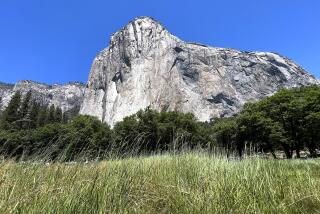Clinton to Order Park Flight Noise Cuts
- Share via
WASHINGTON — With tourist-packed helicopters and small airplanes increasingly raising the decibel level in the skies over the Grand Canyon and other national parks, President Clinton is expected Monday to order government agencies to draw up new measures to reduce noise from such flights.
Administration officials and others familiar with Clinton’s plan said Friday he is likely to issue an order on Earth Day directing the Federal Aviation Administration and the National Park Service to prepare the plan within 90 days, and to put it in place by the end of the year.
If carried out, officials said, the order would reverse the steady increase in noise pollution from airplanes that buzz some of the most remote sites of the Grand Canyon and other national parks and monuments, including Yosemite and Rocky Mountain national parks.
Clinton’s directive to government agencies, a draft copy of which was obtained by The Times, also instructs the Interior Department to draw up a plan to reduce auto traffic in the parks by improving public transportation, particularly at Grand Canyon, Yosemite and Zion national parks.
“It’s in the works,” said one administration official.
But he cautioned that the FAA could yet persuade the White House to dilute the plan. The official and others said the agency tried in the past to undermine efforts to restrict the flights.
The anticipated move restricting commercial sightseeing flights was applauded by the president of the Grand Canyon Trust, Geoffrey Barnard. He said in an interview that even with flight restrictions imposed under the 1986 National Parks Overflight Act, “we’ve seen a steady erosion of quiet.”
“We’ve been working on this for years,” he said. “It’s a spreading problem” that is growing throughout the 27 national parks and monuments along the Colorado River plateau.
But an aide to Sen. John McCain (R-Ariz.), author of the 1986 legislation, accused Clinton of grandstanding “to make it appear he is doing something the [1986] law already requires him to do.”
“It sounds unnecessary--but it might be politically advantageous,” said the aide, who spoke on the condition of anonymity.
Flight tour operators also raised objections when told of the administration’s plans.
“All of the evidence we’ve seen so far indicates there isn’t a significant problem at the Grand Canyon,” said Dan Anderson, president of an organization representing flight operators, the U.S. Air Tour Assn. of Alexandria, Va.
The 1986 legislation directed the FAA and the National Park Service to put regulations in place to reduce noise pollution. They developed a plan that prohibited flights below the canyon’s rim and banned aircraft operations in certain areas.
But the Clinton administration says the problem has gotten worse.
In a report to Congress in 1994, the Interior Department said the limits on tour operators were failing to cut down on noise pollution that destroyed the solitude of the parks.
*
The department said that unless new restrictions were imposed by the year 2010, less than 10% of the park would experience acceptable levels of noise.
“The problem isn’t going to be resolved by minimum altitude rules,” George Frampton Jr., an assistant Interior secretary, said at the time.
According to the Grand Canyon Trust, a private organization that seeks to conserve natural and cultural resources in the Grand Canyon region, air tour operators flew 800,000 visitors over the park in 1994, the most recent year for which statistics are available.
“It’s one flight every two minutes in remote areas of the canyon where people go backpacking to get away from noise,” said one official of the organization. “It’s virtually constant aircraft noise in certain areas of the back country.”
Specifically, the plan that the FAA and the Park Service would develop would address three elements of flight operations: the air corridors pilots could use, daily hours of operation and incentives to introduce quieter aircraft to the fleet.
“The proposal looks kind of grim,” said Rick Carrick, director of operations at Papillon Airways Inc. of Grand Canyon, Ariz.
“Over 90% of the park, you hear nothing,” he said.
The flights allow visitors with restricted mobility to see the canyon, he argued. Also, he said, aerial sightseers leave no lasting impact on the canyon environment.
“If the only visitors were air tourists, 2,000 years from now, the park would be unchanged,” he said. “We are looking, but not touching. This [touring by air] makes the most sense.”
More to Read
Sign up for Essential California
The most important California stories and recommendations in your inbox every morning.
You may occasionally receive promotional content from the Los Angeles Times.













